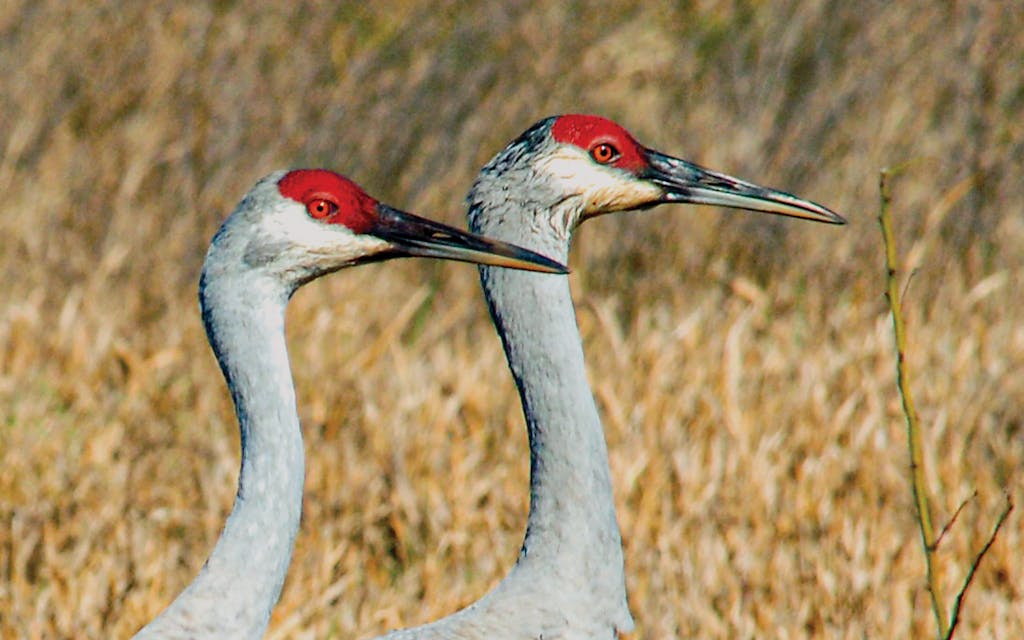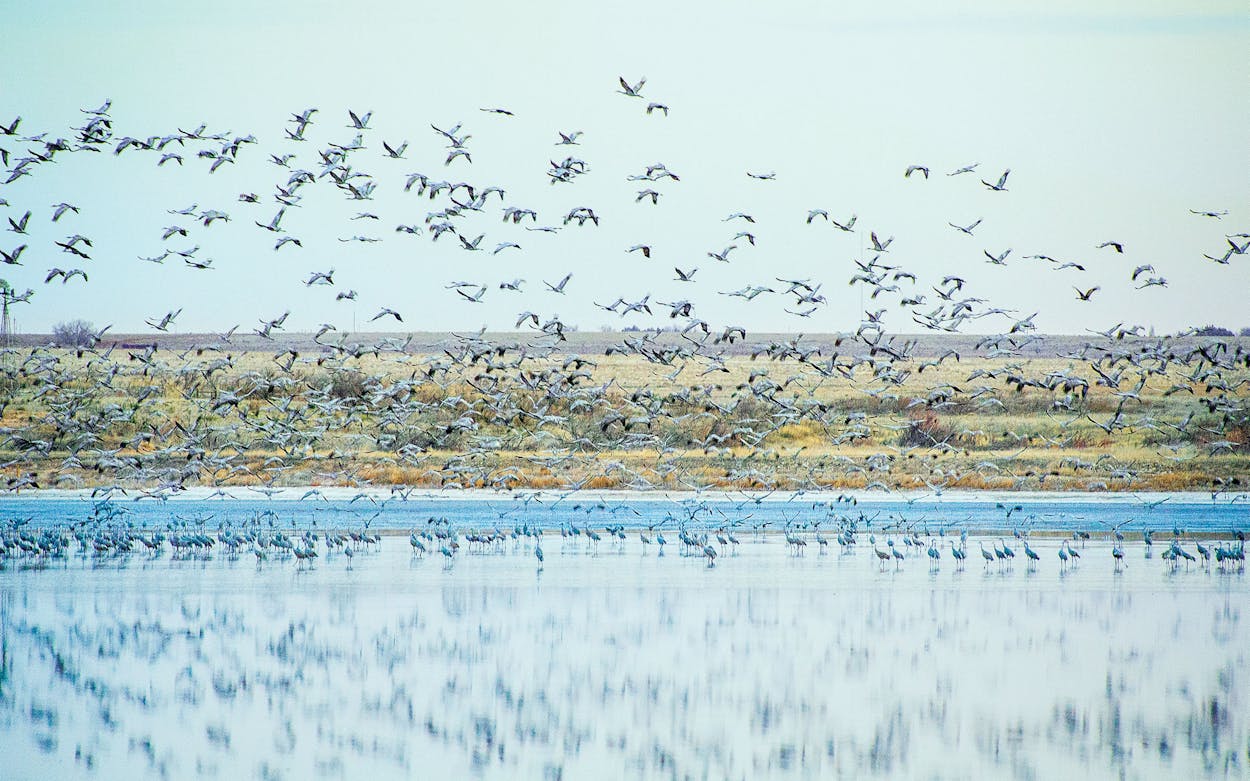Before sunrise on a January morning, I’m driving on Texas Highway 114, heading an hour northwest of Lubbock to the Muleshoe National Wildlife Refuge. Every winter, this remote, under-the-radar park hosts one of the world’s largest migratory gatherings of lesser sandhill cranes—elegant, gray-bodied, red-capped creatures that often stand close to four feet tall. It’s just after six, and a full moon hides behind a heavy bank of clouds. Save for an occasional light emanating from the few farm buildings and houses that dot the road, the darkness outside is total. Every now and then, a tumbleweed rolls through the beam of my headlights.
After I turn onto a caliche road to enter the property, I count four jackrabbits hopping about in the brush. The oldest national wildlife refuge in Texas, Muleshoe is also home to mule deer, bobcats, coyotes, horny toads, and prairie dogs—but I’m here for the cranes. Every winter, as many as 150,000 lesser sandhill cranes, or about 15 percent of the subspecies’s North American population, pass through the refuge’s 6,440 acres of windblown prairie. By day, the birds fly to nearby fields to forage for bugs, seeds, and grasses. At night, impressive seas of them roost on one of Muleshoe’s three saline lakes, huddling together for warmth and protection from predators. To watch them take wing in the morning, I’ve heard, is a spectacular sight. Hard-core and casual birders alike travel here from across the nation (and from as far away as India, Japan, and France) to see the cranes ascend by the thousands and to listen to their raucous bugling. While I’m not much of a birder, I wanted to witness the avian pageant after stumbling across some mind-boggling YouTube videos.
This morning, only two other vehicles are parked next to Paul’s Lake, where the cranes have chosen to winter this year. Refuge manager Jude Smith and wildlife specialist Nick Pope wave hello as I drive up while they sit silently, each in his own pickup, sipping coffee from steaming mugs. The temperature is hovering around 18 degrees, so no one is in a hurry to venture out—and neither, it seems, are the cranes.
There’s a sliver of moonlight now, and I can just make out a big, dark shape on the water. That must be the flock, but there’s no movement and certainly no birdsong. “Just like us, they’re a little slower to wake up on a chilly morning,” Smith had told me the day before, adding with a chuckle: “You picked one of the coldest days of the year to come out here.” I turn off the engine, and my fingers and toes promptly start to go numb despite my wool gloves and two pairs of hiking socks. The chill cuts through my down jacket and thermal layers. I pick up my binoculars and settle in for a long wait.
Sandhill cranes get less of the limelight than their larger, endangered relative, the whooping crane, but they are just as extraordinary. Though tall and gangly, with a wingspan that can reach more than six feet, a lesser sandhill moves with the fluid grace of a ballerina. (Greater sandhills are only slightly larger. The precise number of subspecies, and how to tell them apart, is a subject of debate among wildlife biologists.) A sandhill’s plumage is quite chic: a velvety, light-gray coat, often flecked with gold, and an eye-catching crimson cap so vivid it appears slightly unreal. (This scarlet forehead is pigmented, featherless skin.)
Watching a crane stalk through a field, perched on slender black legs, can make you feel as though you’ve been transported to another era, and in a way you have: sandhills are one of the oldest bird species on the planet, a kind of living fossil. A bone fragment from a crowned crane found in Nebraska, very similar to that of the sandhill, has been dated at around 10 million years old. And another bit of bone, an estimated 2.5 million years old, was determined to have come from a bird genetically identical to sandhills we see today. Marveling at this, the nature writer Aldo Leopold wrote of the crane: “When we hear his call we hear no mere bird. We hear the trumpet in the orchestra of evolution. He is the symbol of our untamable past.”
Smith puts it a little less rhapsodically. “They’re real neat birds,” he says. He grew up just across the New Mexico state line, in nearby Clovis, and has worked at the refuge for nineteen years. An avid hunter, he used to shoot sandhills, whose breast meat is so tasty and tender that it’s nicknamed “ribeye of the sky.” Though he still eats it on occasion, Smith doesn’t pull the trigger much anymore. “After you study ’em for all these years, and learn how old they get and how smart they are, I just lost interest,” he says. Sandhills can live to be more than thirty years old, and they mate for life.

Today, Texas enforces bag limits on sandhill hunting, during limited seasons. The birds are listed as a “species of least concern”—but that wasn’t the case in the early twentieth century, when overhunting and habitat loss dramatically reduced the population. That history is part of the reason Muleshoe exists. In 1935, President Franklin Roosevelt signed an executive order creating the sanctuary as Texas’s first national wildlife refuge (the state now has 21). The U.S. Works Progress Administration sent more than one hundred workers, young men who needed jobs during the Great Depression, to build roads and dig lakes on the newly acquired land. The goal was to create habitat for ducks, geese, and cranes, which Roosevelt and his fellow conservationists had only just realized were on the decline. Researchers estimate that in the thirties, there were only about 35,000 lesser sandhill cranes; today, thanks to migratory bird sanctuaries like Muleshoe and to a federal hunting ban that lasted through the mid-1900s, the healthy population is nearly one million.
Wildlife management was established as a discipline in the United States in the thirties, Smith says, and Muleshoe “was one of the first spots.” It’s also one of the last relatively untouched prairies in Texas, a delicate ecosystem that is vanishing elsewhere in the state as sprawl and development pave over native grasses. Just as Native Americans once did, the refuge staff carry out prescribed burns about once a year to clear away dry brush. “This is one of the few places [near] the Panhandle that has never been plowed,” Smith says. “You can see what the land looked like one hundred fifty, two hundred years ago.”
The prairie might seem quiet and plain at first, a never-ending sea of yellow grass—but sit and listen for a spell, and it becomes clear that Muleshoe teems with life. Mule deer slip like shadows through the tall grass, cicadas buzz, and bobcats pad on furry paws across the campground. Perhaps because of its far-flung location, the park is rarely crowded with human visitors, even during crane season, which typically runs from November through January. Smith estimates that about 30,000 people visit Muleshoe each year—compared with the more than 250,000 who check out Enchanted Rock State Natural Area, in the Hill Country. That’s just fine by Smith and his staff of three. “It’s one of the few places besides far West Texas where you can really get solitude,” he says.
To the cranes, however, Muleshoe is more like a big, noisy party. Midway through their winter range, the final leg of a journey that can stretch as far as five thousand miles—winters in Texas and Mexico, summers as far north as Alaska and Siberia—many of the birds begin their elaborate courtship rituals here. Kathryn Brautigam, a wildlife ecologist who recently wrote a dissertation on sandhills to earn her doctorate from Texas Tech University, says it’s a sight to behold. The male might twirl his body, flap his wings, bow his neck, or even use his beak to toss sticks in the air, all while vocalizing loudly. If the female is impressed, she’ll reciprocate. “You’ll have a distinctive body shape and a song going on at the same time, bouncing back and forth to one another, almost like they’re ice skaters,” she says. “At the beginning of sunrise, there can be ten thousand cranes on the shallow wetland, and they’ll begin popping up and down like popcorn. That’s part of reinforcing the pair bond, a way of saying, ‘Hey, I’m here,’ and then they take off together.” These couples stay together for decades, often retracing the exact same migratory path.
For her dissertation research, Brautigam trapped the birds and outfitted them with GPS trackers, following them for four years. She was stunned by the precision of their routes. “I was really taken aback,” she says. “Sometimes they nest within mere meters of the previous year’s nest.” The cranes are at ease here, in part because the weather is often the mildest they’ll experience. “The warmest part of a crane’s life is when they’re wintering in Mexico and Texas,” she says. “This is like a tropical vacation compared with their breeding season.”
On Paul’s Lake at dawn, it sure doesn’t feel tropical to me. The temperature has risen to about twenty degrees now, and a slight wind stirs the prairie grass. We’ve been waiting in our cars for the better part of an hour; I wiggle my toes to keep them from going completely numb. As the sky lightens, the amorphous dark shape on the lake starts to come into focus, and I can make out pairs of black legs and gray wings. The sandhills pack closely together not just for warmth but for protection from coyotes, bobcats, and other creatures that want to eat them. They are drawn to the refuge’s lakes because they are so vast—this one spans 163 acres. Wide, open spaces like these allow the cranes to see any approaching predators long before they arrive. The water surrounding the flock also acts as a security system: should a predator splash through, the birds on watch—“There’s always someone awake,” Smith says—will hear the noise and sound the alarm.
This morning, all is quiet. Another twenty minutes tick by, and still nothing happens, though I notice my mind’s inner chatter less and less, as if a volume knob on a stereo has been turned down. One of the best parts about birding, friends who practice the hobby have told me, is the tranquility and the stillness; now I get what they mean.
Then I see it: the popcorn-like movement Brautigam had described. A few birds are jumping up and down, while others start to stretch their wings and then collapse them, like so many spindly umbrellas. The movement ripples through the flock until it encompasses hundreds of sandhills. When I see the first one take flight, I hop out of the car, joining the two biologists as they exit their trucks, and we walk closer to the lake, our breath condensing in the chilly air. Soon dozens, then hundreds, then thousands of cranes are streaming into the sky, heading southeast to farmers’ fields, where they will spend the day feeding. Despite the cold, we stand entranced for more than thirty minutes, silently watching this otherworldly sight.
The long black trail that snakes across the sky reminds me of how bats take flight from under the Congress Avenue Bridge in Austin during summer sunsets. But while that flight is relatively quiet, this one is more like a symphony. I begin to see why birders use the word “bugling” to describe the call of a crane. One sandhill might trill as daintily as a piccolo, while another squawks with all the grace and elegance of a tuba. If I try to follow any one bird with my eye, its path appears random and uncoordinated. Yet somehow, it all comes together into a coherent whole, a shifting shape in the sky with an intelligence of its own, able to rapidly change direction in response to a gust of wind or a swooping eagle. When I ask Smith how the cranes decide where to fly, roost, or feed, his first response is a shrug. Scientists are still learning what drives this behavior, often with the help of computer models.
Smith eyeballs the size of the flock through his binoculars, estimating that we’re looking at about five thousand airborne sandhills—a below-average number for this time of year. Many have likely moved on to another roost in the area. Soon, they’ll fly toward Canada and Alaska, where they will mate and raise their chicks. “A week ago, we had fifty thousand,” he tells me. The spectacle is already so immeasurable, my entire field of vision filled with cranes, that I can’t even imagine what it would be like to see that many.
Months later, when I check in with Smith, he tells me that the crane outlook for the upcoming winter is strong. I start dreaming of my next Muleshoe excursion. Maybe I’m a birder after all.
This article originally appeared in the December 2022 issue of Texas Monthly with the headline “Crane Spotting.” Subscribe today.









